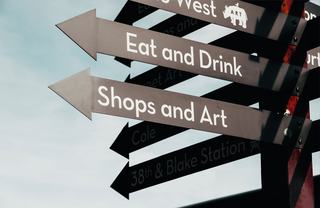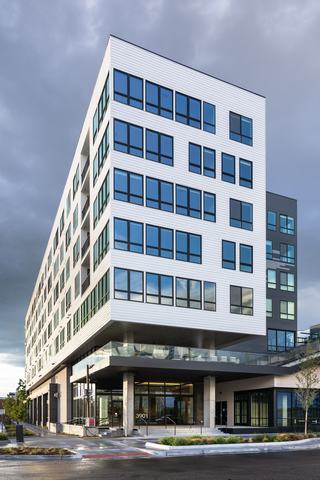Q&A: Everything You Want to Know About RiNo Denver

Denver’s River North Art District—better known as RiNo—has grown from warehouses and rail yards into one of the city’s most dynamic cultural hubs. It’s a neighborhood where art spills into the streets, breweries fill converted factories, and rooftops frame sweeping views of downtown and the Rockies. Below, we answer some of the most common questions people have about RiNo today.
Q: What does RiNo stand for?
A: RiNo means River North Art District. Locals pronounce it “rhino,” and the animal logo has become a familiar symbol throughout the neighborhood.
Q: Where exactly is RiNo in Denver?
A: RiNo sits just north of downtown. Its rough boundaries stretch from Park Avenue West to I-70, bordered by I-25 to the west and Arapahoe Street to the east. Its central location makes it easy to reach while still maintaining its own distinct identity.
Q: How long has RiNo been an official arts district?
A: RiNo began informally as an artist-driven movement in the early 2000s. By 2014, it was officially recognized by the state as a Creative District, solidifying its reputation as Denver’s creative core.
Q: Why is RiNo so popular?
A: RiNo thrives on its blend of old and new. Industrial warehouses have been reborn as art galleries, taprooms, and co-working spaces. Bright murals transform alleys into open-air galleries, while food halls, boutique hotels, and apartments bring in steady foot traffic. It’s a neighborhood that’s both gritty and polished, a place that feels like Denver at its most creative.
Q: What are the main streets to explore in RiNo?
A: Larimer Street, Walnut Street, and Blake Street are the main arteries. Each is lined with restaurants, galleries, shops, and large-scale murals, making them ideal for an afternoon walk or a night out.
Q: Where can I find the best street art?
A: Nearly every block in RiNo features murals, but Larimer Street between Broadway and Downing is especially mural-dense. Many visitors join guided graffiti or mural tours to learn about the artists behind the works. Check out the Denver Graffiti Tour; the Rino Arts District site also has a complete list of murals. Beyond street art, RiNo also has a host of dynamic art galleries and artist studios to explore and purchase original works from.
Q: What’s the food and nightlife like?
A: RiNo is home to Denver Central Market and The Source—two foodie destinations that anchor its dining scene. Restaurants like Beckon, Safta, and Hop Alley draw national attention, while bars such as Finn’s Manor, Improper City, and Death & Co keep the nightlife vibrant. The Mission Ballroom, one of Denver’s premier music venues, is also here, hosting concerts in a flexible 4,000-capacity space.
Q: What’s new in RiNo?
A: Development continues to reshape the district:
* Denargo Market Park (opened 2025) brings over four acres of green space with a playground, riverwalk, and a climbable rhino sculpture.
* F1 Arcade (opening fall 2025) adds a 15,000 sq. ft. racing simulator venue with 69 simulators, a bar, and terrace.
* RiNo Made Pop-Up Program activates empty storefronts by giving artists rent-free studios and exhibition space.
Q: Can you really drink and walk around RiNo?
A: Hopefully soon you’ll be able to. Denver approved its first common consumption area here near Mission Ballroom, where visitors can carry drinks between participating bars within a designated zone.
Q: Is RiNo walkable and easy to get around?
A: Yes. The streets are flat and compact, making it easy to explore on foot or bike. The South Platte Trail also runs along the edge of RiNo, and the RTD A-Line light rail at 38th & Blake connects directly to Union Station and Denver International Airport.
Q: Is RiNo bike-friendly?
A: Yes. Brighton Boulevard’s rebuild delivered 2.6 miles of sidewalks and a separated cycle track plus new crossings, lighting, trees, and racks—so riding to breweries, galleries, and markets is straightforward. The district also backs onto the South Platte River Trail via the Arkins Promenade, an elevated riverfront walkway between 35th–38th Streets that connects into the regional path network.
Q: What unique shops or experiences are in RiNo?
A: Lots! RiNo offers the Oakwell Beer Spa, a spa-meets-taproom concept. Tucked-away shops like the Spicy Librarian bookstore will have your next great romance read. Check out Backyard on Blake for a collection of local shops, cafes, restaurants and bars; DUER for premium performance denim; FTF GOODS for curated gifts and finds; Little Pond Love for beautifully handmade jackets and wraps; Modern Nomad for home decor; and more.
Q: What’s the real estate scene like?
A: RiNo’s mix of architecture is part of its charm. You’ll find historic brick warehouses converted into lofts, sleek new luxury apartments (hello Forge!), modern condos, and townhomes—all blended with street-level retail and creative studios. It’s become one of Denver’s most desirable places to live for those who want an urban setting with character.
Q: How can people get involved in the local arts scene?
A: The RiNo Art District offers open gallery nights, First Friday art walks, community events, and opportunities for residents to volunteer or exhibit. It’s a neighborhood where the arts aren’t just displayed, but actively supported and shared.
Q: Are there green spaces or parks in/near RiNo?
A: Several—and more keep opening. Denargo Market Park just debuted 4+ acres of riverfront green with a playground and a giant climbable rhino sculpture along Arkins Court & 29th. You’ll also find the Rino Art Park campus on the river, nearby Globeville Landing Park (north), and City of Cuernavaca Park (south) along the South Platte. Also check out the Arkins Promenade.
Q: If you’ve got one day in RiNo, what should you do?
- Morning: Coffee at Crema Coffee House on Larimer, then a mural stroll along Larimer/Walnut/Blake.
- Midday: Lunch and grazing at Denver Central Market or The Source Hotel + Market Hall).
- Afternoon: Walk the Arkins Promenade and riverfront; pop into RiNo ArtPark if programming’s on.
- Evening: Catch a show at Mission Ballroomor settle into Nocturne Jazz & Supper Club; wrap with a cocktail at Death & Co in the Ramble Hotel.
Q: What are five must-visit restaurants in RiNo right now?
- Beckon — Denver’s Michelin-starred chef’s counter tasting menu on Larimer.
- Hop Alley — Modern Chinese from Tommy Lee; Michelin Bib Gourmand.
- Safta — Israeli cooking inside The Source Hotel; Michelin-recommended.
- Temaki Den — Hand-rolls and aburi nigiri in The Source’s market hall; Michelin-recommended.
- Work & Class — Long-running favorite for wood-roasted meats and seasonal plates on Larimer.
Living the RiNo Lifestyle
RiNo is a district that evolves daily—murals are painted over with new works, restaurants debut in converted garages, and rooftops frame ever-changing views of the skyline and mountains. It’s Denver’s creative playground, but also increasingly a place to call home. For those who value art, culture, and connection, RiNo offers a lifestyle you won’t find anywhere else in the city.







